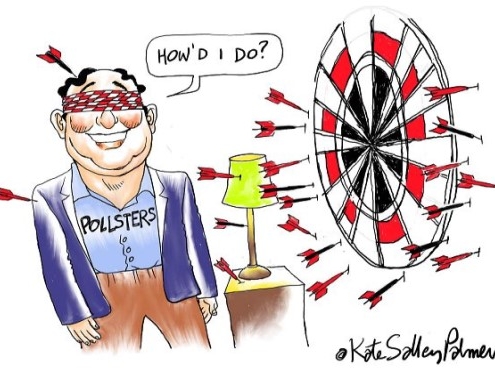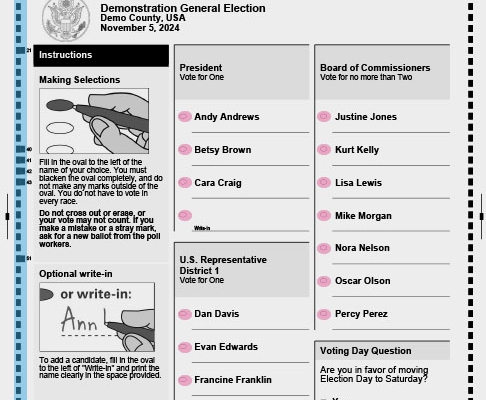People all over the world are offering social media takes on the US Presidential election that range from gullibly wrong to dangerously misinformed. Because the stakes are so high, spreading misinformation, even accidentally, could have a serious impact on public perceptions of the legitimacy of the process. Understanding basic facts about the US system and the dynamics shaping the race will help you avoid contributing to an information stream already filled with burning garbage.
- Polling American Elections is Hard and Most Pollsters Try to Get it Right: It’s lazy to fall back on “but the 2016 polls were wrong!” When every adult in a country is both eligible and likely to vote, random selection for election surveys is easy. Everyone qualifies for the survey. In the US, about 70% of the electorate is registered to vote and only 55%-65% of those cast a vote. Pollsters have to apply art and science to predicting the profile of likely voters. Sometimes their assumptions are wrong.

Actually Not That Funny
Most pollsters operate in good faith though and are transparent about their selection methodology. Find out which pollsters are hacks and learn how to interpret the good ones’ methods. Amplifying garbage polls undermines public confidence in the science as well as the outcome of the election.
- It’s Not 2016, or 1968. Many of us can’t forget 2016. We should. It is not instructive for 2020. The most important difference is that Trump is a very weak incumbent. Incumbent presidents enjoy such huge advantages they are typically very hard to beat (Obama, GWB, B. Clinton). At his current numbers, however, Trump’s re-election would be ahistorical. In defiance of common sense, he is “playing the law and order card.” It’s NOTHING like when Nixon tried it in 1968. Nixon was running for an open seat against an opponent (Hubert Humphrey) who was perceived as weak on law and order! Trump IS the incumbent and also, significantly, a career criminal. Law and order is HIS responsibility and voters think he’s not been doing a great job at it. As a challenger, former VP Biden is reasonably well-liked and very well-known, differentiating him from Democratic challengers in past years (John Kerry in 2004, for example, was less well-known and more easily defined). Finally, two very unpopular, well-known candidates competed for open seat in 2016. That’s a completely different campaign dynamic. Stop saying “but 2016!”
- Many Data Files Are Publicly Available for Use (and Abuse): No, really, ANYONE can go to Ohio’s secretary of state website and download the entire state’s voter file, even Russians! Michigan’s requires a simple FOIA request. Russians figured that out, so you can too. Nearly every state’s voter registration records are accessible for free or a small cost. No one needs to “hack” anything to get them. Contribution records at the Federal Election Commission are also publicly available. Most states also provide up-to-date counts of how many mail ballots have been sent out and received and so much more. Every campaign runs on these data. The flip side is that legally-obtained public data can be also used for evil purposes. Get to know the Secretaries’ of State websites and learn to tell the difference.
- Look for Vote Suppression Rather Than Fraud: In the US, states and counties administer elections. There is neither a central voter database nor administrative structure. With more than 3000 counties, coordinated, large scale interference in vote counting is extremely hard to do. Voter fraud is extremely rare. Most American election administrators at the state and county levels are non-partisan and professional. However, political power is a hell of a drug. Partisan counties and states have other tools at their disposal, such as voter file purges, closure of polling places in particular neighborhoods, using security forces for intimidation or tactical COVID lockdowns that could contribute to vote suppression. Voting and election fraud is rare, hard to do at scale and easy to detect. Vote suppression is well-documented, much easier to do and harder to detect. Look for it.
- There is No “Election Day” Anymore: Nearly 25% of votes were cast by mail in 2016 and it will be higher in 2020. Many Americans, like me, will receive ballots by mail in mid-September and will send them back immediately. Elections in Oregon and Washington have been entirely vote by mail (VBM) for years. Voters

Your Ballot May Vary
and administrators are comfortable with the process. Other states, like California, have a hybrid system (65% vote by mail). Still other states make it very hard to vote by mail. COVID has forced those states allow forms of VBM to diminish the risk of spreading the virus. Because of COVID chaos, it’s hard to know which voters will choose to VBM if they have the option. Despite the fact that VBM fraud is extremely rare, that it advantages neither party when done at scale and voters who have it love it, some forces have chosen to politicize it (while at the same time encouraging their supporters to…vote by mail). Here’s a solid guide to what’s important to understand about VBM. Don’t buy into BS.
- We Won’t Know the Results on “Election Night:” We all love watching the networks “call” races as votes are counted and “precincts report” on election night. That’s not going to happen in 2020. Get over it and go to bed early. States start counting ballots on election day after polls close, but how they process mail ballots differs. It may take days or even weeks (hello, California!) to know the results. Because in-person votes may be demographically different than mail votes, we shouldn’t make any calls until mail votes are counted. Anyone, especially the President, who draws conclusions about the results before mail ballots are counted is willfully undermining the process. Don’t help him. Count the votes first, then announce results. We can wait.
